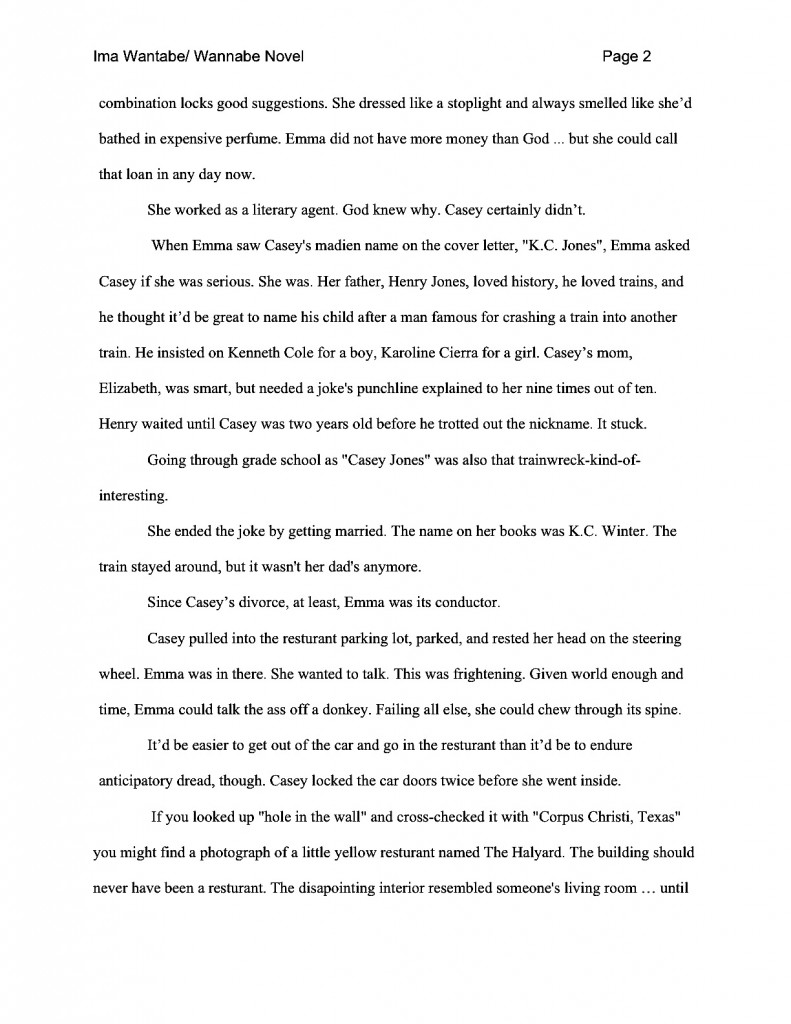
A quick reminder before we get begin today’s free-for-all: this coming Monday, May 31, is the deadline for the Author! Author!/WHISPER Great First Page Made Even Better Contest. To allow each and every one of you to squeeze every last second of productive time out of your Memorial Day weekend, entries do not need to be date-stamped until midnight in your time zone.
I would especially love to see entries from those of you who have spent the last couple of weeks reading my super-close analysis of a reader’s opening pages and slowly turning bright green with envy: here is your chance to subject YOUR first page to similar scrutiny, free, gratis, and without charge. And not only my scrutiny, either: the quite genuinely fabulous Phoebe Kitanidis, author of the newly-released YA novel WHISPER, has graciously agreed to join me in this critiquing venture.
The complete rules, should you care to take a peek at them, may be found here. We shall now rejoin the blog already in progress.
Yesterday, as sometimes happens, the universe obligingly stepped up and provided me with a simply delightful metaphor for what we were already in the depths of talking about here at Author! Author! Accompany me, if you will, to the wildlife-harboring, honeybee-attracting, neighbor-annoying thicket of blackberry bushes that spans the wee creek running outside my house.
Okay, so maybe the snapshot above doesn’t really give you much of an idea of it. If you squint at that mass of green behind the trees, though, you may see the yellow glint of raccoon eyes.
Due to a brisk little bout of rezoning a few years back, all of the land above us on our hill has been concreted or asphalted over, so we like to keep some of our yard wild for the sake of the critters. (Also, so the abundant local rainfall has someplace to go — hasn’t anyone else noticed that as more and more land is paved and built over, overflowing rivers have less and less ground to suck up excess? Why is anyone surprised that flooding ensues?)
Not all of our neighbors are crazy about our impromptu wildlife sanctuary. Why, only last autumn, one set of civic-minded folk expressed their aesthetic opinions by flinging a large wooden pallet formerly used for their building materials into the aforementioned blackberry bushes.
I was all for moving it immediately: it was partially on public land. What if, I asked my significant other, the city suddenly took it into its collective head to cut back the part of the thicket that impinges upon the road, as it occasionally does? Once the blackberries grew over the pallet, wasn’t a sleepy public employee only too likely to run his mower smack into it? And since I was neither physically strong nor raccoon-repellent enough to extricate the pallet from its green grave myself (wildlife interprets my cries of “Shoo!” as “Here’s your dinner!”), was my SO not the logical candidate to head off that municipal disaster by moving the silly thing before, say, any city-owned machinery were permanently incapacitated and we were fined?
In the time-honored tradition of inter-spouse communications all over this great land of ours, my SO chose to regard these questions as purely rhetorical. He must have found them interesting food for thought, however, if not action, as the pitter-patter of tiny raccoon feet on wood slats prompted me to repeat these questions roughly once per month. I can only attribute his not actually doing anything about the pallet to a great and abiding love of the sound of my voice — and to an oft-expressed opinion that the neighbors should clean up their trash themselves.
Yesterday, about a month after the neighbors in question had moved away (much to the relief of local wildlife), I was startled from my daily creative reverie by the immistakable racket of heavy machinery being driven up our hill by someone rather unused to the task. The clipper attachment dragged on the ground.
I went running into my SO’s study. (Actually, I limped slowly, due to my recent back injury, but allow me a bit of creative latitude here.) “They’ve come for our blackberry bushes! Did you ever manage to move that pallet?”
He admitted that he had not; the neighbors, he said, should have taken care of it. Upon further questioning and a spirited discussion on the nature of reality vs. wishful thinking and the annoying imperatives of linear time, he was heard to opine that it was now too late now to do anything about it.
Well, as long-time readers of this blog are, I hope, quite well aware, I’ve never been a big fan of letting fixable problems just lie there. Upon my repeated urgings, he begrudgingly invested the roughly 2 1/2 minutes required to shout at the operator to stop, free the pallet, and moving to our garbage bin. He explained glibly throughout about the nature of linear time and our deadbeat ex-neighbors’ ethical shortcomings.
The municipal handyman was effusively grateful. “I never would have seen that. It would have smashed up my machine.”
“Naturally,” my SO said, with a perfectly straight face. “Anyone could have predicted that.”
What does this little domestic homily have to do with our ongoing discussion of necessary manuscript revisions, you ask? Why, I should have thought that was obvious: if you wish to please a professional reader like Millicent the agency screener, there’s just no substitute for taking the time to learn the rules of grammar, spelling, structure, and formatting, incorporate them consistently into your text — and then, before you submit your manuscript, double-checking how you have implemented those rules by reading your submission IN ITS ENTIRETY, IN HARD COPY, and OUT LOUD.
Oh, that wasn’t your first thought after reading that anecdote? How puzzling. What about if I put it this way: if you know the rules but don’t implement them every time, you should expect Millicent to be annoyed when she stumbles over them in your submission.
But most of us writers don’t expect that, do we? In fact, even the submitters of the most egregiously error-prone manuscripts and contest entries are both astonished and hurt when agents, editors, and contest judges respond as though not unprofessionally-presented writing were bad writing, or as if an apparently unproofread first page were an infallible indicator of a manuscript rife with spelling, grammatical, and logic problems.
To spare anyone reading this any shocks in future: they will respond that way, predictably. In their minds, it’s the writer’s job to free a manuscript of distracting errors, rather than a professional reader’s job to try to see past those errors in order to discover new writing talent.
And it’s not enough to present your writing professionally in some parts of your manuscript and not others, either; a pallet hidden deep in the weeds is as likely to wreck the machinery as one left out in the open. But if the inflexible rules of spelling, grammar, and connective logic are the necessary foundation of a strong submission, consistency is the hallmark of a strong authorial voice.
Just in case I’m being too subtle about what this means for submissions: the Millicents of this world just abhor inconsistency in manuscripts, whether those gaffes lie in the realm of format, spelling, grammar, story details, style, or tone — and with good reason. People who read manuscripts for a living are trained to spot and deplore unevenness.
That’s the bad news. Here’s the good news: as a result of this necessary but rather pedantic focus, a manuscript whose voice is sure and consistent tends to strike Millicent’s tired eyes like the sight of a cool river on a blazing summer day.
Why is it such a rare sight? Well, think about it: very, very few of us, no matter how talented we might happen to be, find our authorial voices the first time we sit down to write a novel. Or memoir. Or any other type of book, for that matter. It’s not even all that uncommon for a good writer to finish the first draft of her first novel, only to discover that her voice is significantly stronger, or even quite different, at the end of the book than at the beginning.
That should not surprise us very much, should it? After all, no one is born a technically perfect writer. And even after a writer has honed her professional toolkit, consistent authorial voice requires work to produce — and usually quite a bit of revision and re-reading.
Those of you who write only when you feel inspired are squirming right now, aren’t you?
I’m not astonished by that reaction — all too often, we writers talk about voice as though it were more or less synonymous with talent, as if it were something a writer is either born with or not. I don’t think that’s true. Oh, it’s true enough that talent can’t be learned, but craft can be, and many a great sentence-builder has missed becoming a great writer because she relied too much on the former at the expense of developing the latter.
Here’s a novel thought: consistent voice is almost always the product not of original inspiration, but of conscientious revision.
Let that one sink in for a moment. I’ll wait. I’ve got this pretty view to ponder.
Voice is more than self-expression, a way of writing a sentence, or even inspiration: it’s tone, level of detail, analytical perception, sense of humor, rhythm, and all of the other hyper-personalized ways in which one writer tells a story differently than another. Learning to wield these weighty tools to produce a consistent and seemingly effortless result takes practice, patience, and much trial and error.
Or, to put it another way: it’s a whole lot harder to write a good book than a good individual sentence, paragraph, or scene. Why? Because the alchemy doesn’t need to come together only once, as it does in a well-written sentence; it has to come together every time, and in a similar way.
On an artistic level, I’m always thrilled when a client (or any other talented writer, for that matter) finds her voice, but as an editor, I know that in the short term, it means a lot more work to come. Because, you see, once a writer discovers the right voice and perspective for the story he’s telling, he will have to go back through the rest of the book with a fine-toothed comb, to make the voice that now has emerged sound consistent throughout the entire story.
Which brings me, rather neatly, back to the Frankenstein manuscript, doesn’t it? Funny how that worked out.
A Frankenstein manuscript, for those of you joining us late, is a book that meanders in voice, tone, perspective, structure, and/or style so much that it sounds as though it had been written by a committee, instead of an individual writer. All of these are cobbled together, like the body parts of Dr. Frankenstein’s creature, may create the illusion of a whole entity, but it lacks the spark, the true-to-life continuity of a story told from beginning to end by a sure authorial voice.
To forestall your getting blank looks at writers’ conferences, I should hastily add: this is my personal nickname for such a book, not an industry-wide moniker. (Although since this blog has readers in circles in circles that might surprise you, the term has been gaining currency over the last couple of years.) I assure you, however, every single agent and editor currently working in North America is aware of the phenomenon and dreads it — because they know, as I do, that its appearance heralds months and months of fine-combing to come.
The sad thing is, the Frankenstein tendency is almost always accidental, and generally goes entirely unnoticed by the writer. Especially, alas, a writer so excited by an agent’s request for materials that he simply prints out the latest version of his manuscript and sends it off right away. Regardless of where it might happen to be in the revision process, getting it out the door before the requesting agent changes her mind seems more important than taking the time to make sure that each and every revision has been implemented consistently all the way through the manuscript.
I won’t make those of you who have fallen into this trap, only to kick yourself later, raise your hands. You know who you are.
The fact that aspiring writers generally don’t realize that their manuscripts are uneven should not surprise us unduly, right? Writing a book takes a long time: authorial voices, preferences, and even underlying philosophy can change radically over the course of a writing project. As revision is layered on top of revision, many writers become too absorbed in the details of the book to sit down and read it straight through AS A BOOK — which, unfortunately, is the only way to recognize a Frankenstein manuscript.
Let me repeat that, as it’s awfully important: there is absolutely no way to diagnose and treat a manuscript’s Frankensteinish tendencies without sitting down and reading the whole darned thing. Preferably IN HARD COPY, IN ITS ENTIRETY, and OUT LOUD, in as few sittings as possible.
If the prospect of improving artistically is not enough to set you running for your comfy reading chair, pronto, here’s an excellent marketing incentive to send you scurrying in that direction, manuscript in hand: unfortunately for writers of Frankenstein pieces, reading a manuscript straight through, at least the first part of it, is how agents and editors determine whether they want to work with an author.
Translation: if you don’t catch the problem, they will. If you have a Frankenstein manuscript on your hands, you are far, far better off recognizing the fact yourself before you submit it, because from the diagnosis of professionals, there is no appeal.
Again, not precisely a surprise, is it?
But for most aspiring writers, tackling an entire manuscript, even if its their own, is a rather overwhelming prospect — so much so that many simply dismiss the idea of reading their own manuscripts in their entirety, much less fixing them, as impracticable. To assuage some of those fears, let’s embrace the old-time editors’ trick of attacking only one manuscript megaproblem at a time.
Seriously, revision is a process, not a one-time deal: breaking up that immense task into bite-sized pieces and eating them one at a time is far more sensible than trying to force your psyche to think about every conceivable problem in a 400-page manuscript simultaneously. Worry about the totality of the diagnosing and revising down the line — just for now, focus on only one easily fixable gaffe and repair that.
You can read through your work, searching for only a single problem, can’t you? Piece o’ proverbial cake.
Then, after you are positive that your manuscript is perfect in that respect, pick another megaproblem and work on that — for every page of the manuscript, so you may be absolutely positive that you haven’t missed anything. Repeat as often as necessary. When you are pretty sure that you’ve systematically rooted out all of the ongoing problems, sit down and read your manuscript — wait for it — IN HARD COPY, IN ITS ENTIRETY, and OUT LOUD, to catch any remaining Frankenstein tendencies.
Sound time-consuming? It is. But it’s far, far less likely either to drive you mad or lead you to throw up your hands in despair and abandon the book altogether than trying to tackle a universal revision in one fell swoop.
Don’t shrug off the latter danger as improbable, please: revision burnout is a very real phenomenon. I’ve seen many, many more promising manuscripts tossed into trash cans by their writers out of despair over how long revision might take than out of anger at rejection.
In the spirit of incremental progress, let’s begin with a single, extremely common manifestation of Frankensteinery with an eye to rooting it out of the manuscript: the text that hasn’t yet really decided which tense it is in, and so meanders back and forth between (usually) the present and the past.
In fiction, the explanation for this phenomenon is usually pretty straightforward: the writer thought at one point that it would be nifty to write the book in the present tense, realized part-way through that it’s darned difficult to tell a story that way (how does one writing in the present tense of events that have been in progress for some time, for instance?), and changed to the past. Only in the transition process, not all of the verbs got changed.
Oops. What an annoying-yet-easily-fixable problem.
Spotting this particular Frankenstein problem is great practice for sharpening your editorial eye, because once you’re on the look-out for improper tenses, they will just start leaping off the page at you. (Hint: don’t try to catch them on your computer screen; sit down with a hard copy of your latest draft and a highlighting pen.) Quite quickly, you’ll begin to regard those tense slips in the same light as Millicent does: like an indicator that the writer did not take the time to sit down and re-read his work after revision.
Hmm, where have I heard before that such a course of action really isn’t the best strategic move? I’m sure it will come to me…
Fair warning: sometimes tense slips are intentional. Sometimes — and this one is more common in nonfiction, notoriously so in memoir — the writer just thinks it’s cool to present past events in the present tense. It sounds more colloquial that way, she reasons, the way someone might tell an anecdote verbally.
The trouble is, flipping past actions into the present tense can rapidly become darned confusing for the reader. To illustrate how and why, let’s take a gander at a favorite (and kind of surprising, from so usually consistent a writer) example of mine, Sarah Vowell’s THE WORDY SHIPMATES:
Williams in Salem is such a myopic researcher of biblical truth he doesn’t care who gets hurt. His intellectual fervor, coupled with a disregard of practical consequences, reminds me of nuclear physicist J. Robert Oppenheimer, running his secret Manhattan Project lab in Los Alamos with a single-minded zeal, then quoting the Bhagavad Gita as the first test of his atomic bomb lights up the desert. “Now I am become Death, the destroyer of worlds,” he said.
Now, this paragraph makes perfect sense, on one level: an intelligent reader could figure out that the narrator is in the present, talking about Oppenheimer and Williams in the past. But quick, tell me based upon this passage alone: who was born first, Oppenheimer or Williams?
If you said Oppenheimer, you were following the hint given by the tense choices in this passage. Since Oppenheimer is clearly speaking in the past, and Williams is presented in the present tense, the implication is that Williams is the more recent trodder of the earth’s crust, right? Perhaps even a contemporary of Vowell’s?
So would it astonish you to learn that Williams was obsessing in 1635, not 2008, when the book came out?
For some reason best known to herself, Vowell chose to describe the actions of Williams and his fellow Puritans in both the present and the past tense, sometimes within the same paragraph. Since her background is in radio (by definition a speaker’s medium), I am forcing myself to conclude that this was a well-considered authorial choice, not merely the result of a reluctance to re-read her own work (which she does regularly on NPR) or an editorial oversight.
As a well-established nonfiction writer, she was, obviously, able to get away with this choice, but that does not necessarily mean that the writer of a first book could. As we have often discussed, the standards for breaking into the biz are quite a bit more stringent than those for the folks already in it. So it would behoove you to consider this authorial choice very carefully before submission: when most aspiring writers slip around in time, it’s because they’re trying to mirror the patterns of common speech or believe that actions described in the present tense are more immediate to the reader.
While you are weighing your revision options, you might want to bear in mind that Millicent (a) tends not to be all that big a fan of narrative text that reads just like the spoken word UNLESS the manuscript is written in the first person singular, and (b) very few professional readers believe that ordinary readers are sufficiently now-oriented to prefer the present tense to the past. (“Wait — this isn’t happening right now? Why should I pay attention to it, then?”)
And then there’s the very real possibility that Millicent will simply assume that any slips between tenses are not a narrative choice, but a mistake. A mistake made by — chant it with me now, readers — a writer who did not bother to read his submission IN HARD COPY, IN ITS ENTIRETY, and OUT LOUD, to make sure that the tense choices are consistent.
I like using THE WORDY SHIPMATES as an example of this dilemma, as it is one of the rare cases where reviewers were as uncharitable to a well-respected author’s efforts as Millicent would have been had THE WORDY SHIPMATES crossed her desk as a submission from a previously unpublished aspiring writer. “As a whole,” the New York Post’s reviewer commented dryly, “the book reads like an unedited manuscript.”
Like, in other words, a Frankenstein manuscript.
In Ms. Vowell’s defense, I can think of a number of strategic reasons the frequent tense changes might have seemed like a good idea at the composition stage. Casting so much of the Puritans’ story in the present tense might have been a deliberate attempt to draw a parallel with current political conditions at the time the book came out, for instance (which may be why the book already seems a trifle dated). Or perhaps it was an effort to make the lives of our long-dead forebears seem more immediately relevant to the reader.
But whatever the motivation, I don’t think it worked — which irritated me, as this is an author for whom I harbor a great deal of ongoing respect. As a reader, though, I have to say that I found the frequent temporal shifts jarring every single time they occurred in the book. I thought they made the historical tale she was telling significantly harder to follow on the page.
But some of you out there share the belief that writing in the present tense is inherently more grabbing than writing in the past, don’t you? Certainly, those of you who feel this way are not alone: there has been quite a bit of literary fiction over the last 20 years (particularly short stories) that has embraced that notion that placing a narrative in the now is more immediate.
Personally, I don’t think it’s true, largely because anyone who reads on a regular basis is already well versed in the not-very-difficult mental process of becoming absorbed in a past tense story as though it were happening in present time. A reader has to be awfully darned literal to perceive himself to be distanced from action simply because it is presented in the past tense. I also know from experience that writing an entire book in the present tense necessarily entails quite a few technical difficulties that may be avoided almost entirely by placing it in even the most recent of pasts. Even the most minimal tense slip-up runs the risk of yanking the reader out of the world of the book and back into mundane reality.
All that being said, tense choices are entirely up to the author — if you love the present tense and feel it’s the best means of telling your story, by all means write in it. I ask only one thing, for your own sake: if you’re going to write in the present tense, do it consistently.
Again, if you’re not willing to heed this advice for artistic reasons, embrace it because it’s good marketing. Manuscripts that tense-flip for no apparent reason tend to get dismissed as poorly proofed, at best, and poorly revised at worst. So unless a reader has a pretty darned good reason to assume that your authorial choices are deliberate — like, say, Sarah Vowell’s extensive track record of excellent published writing — assume that he’s going to interpret tense inconsistency not as a matter of style, but as a mistake, and an easily preventable one, at that.
Am I suggesting that you might want to save the major experimentation until after you’re already an established writer? Well, I hate to seem cynical, but it’s usually simpler to break into the book market that way. (The norms of the short story market remain quite different, I am grateful to report.) Many a well-respected literary luminary has cut his teeth on less radical ways to make English prose interesting, then moved on later to challenge the language.
Hey, Nobel laureate José Saramago wrote an entire book devoid of periods. Do you honestly believe that a first-time writer could have gotten away with the same trick?
Yes, yes, I know: it’s unfair that the already-published should be judged by less exacting standards than those just breaking into the biz, but I’m not going to lie to you: that’s how it works. I don’t think that THE WORDY SHIPMATES would have made it past Millicent had it been written by a previously unpublished writer.
Which would have been a shame, as it’s an interesting book with some wonderful insights and some very memorable sentences crammed into it. But plenty of interesting books with wonderful insights and memorable sentences don’t clear the first hurdle at agencies or in literary contests.
Why? Often, because those insights and sentences come across as flukes, occasional narrative bright spots not entirely integrated into the overall narrative. The voice is not consistent.
Cue the monster; he’s on again.
Don’t despair, however, if you fear your manuscript has Frankenstein tendencies. Next time, I shall go into what happens to a Frankenstein manuscript when it reaches an agency or a publishing house — as well as methods you can use to catch and mend the problem before it passes under professional eyes. In the meantime, keep up the good work!










































